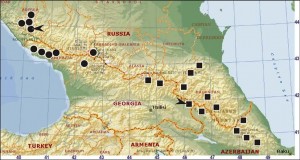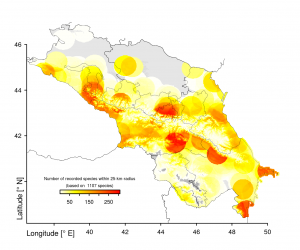Krehenwinkel & Tautz (2013) presented one of the few studies with the first information on high genetic diversity in spiders of the Caucasus Ecoregion. In their study populations of
Argiope bruennichi (Scopoli, 1772) the Caucasus Ecoregion were the only populations — compared to populations in Europe, Russia and East Asia — with all haplotypes present, thus identifying this region as the probable refugial region for western European populations during glaciation events.
The well-known rapid northward range expansion of this species in the last decades was attributed by the authors to genetic admixture of cold-adaptation alleles from East Asian populations.
Ponomarev & Dvadnenko (2013) described Haplodrassus caucasius and sketch its distribution from Krasnodar Region eastwards to Dagestan.

Distribution map from Kovblyuk et al. (2013: 71).
Kovblyuk et al. (2013) described Pireneitega ovtchinnikovi and the male of P. spasskyi (Charitonov, 1946). Both species are vicarious species: P. ovtchinnikovi in the Western Caucasus Major and P. spasskyi in the Eastern Caucasus Major. The authors also identified all specimens of P. segestriformis (Dufour, 1820) from the Caucasus to be misidentified specimens of P. ovtchinnikovi.
With these updates, the database now runs as Version 1.4.1 (see details).
 Starting now in August 2017, the database will be updated in shorter intervalls with versionnumbers giving month and year, e.g. 08.2017. This should allow (and motivate) me to work on the database more often, not only in a bulk action every two years or so.
Starting now in August 2017, the database will be updated in shorter intervalls with versionnumbers giving month and year, e.g. 08.2017. This should allow (and motivate) me to work on the database more often, not only in a bulk action every two years or so.
![By 池田正樹 (talk) masaki ikeda (Own work) [Public domain], via Wikimedia Commons](http://caucasus-spiders.info/wp-content/uploads/2014/02/263px-Argiope_bruennichi_08Oct10-197x300.jpg)
